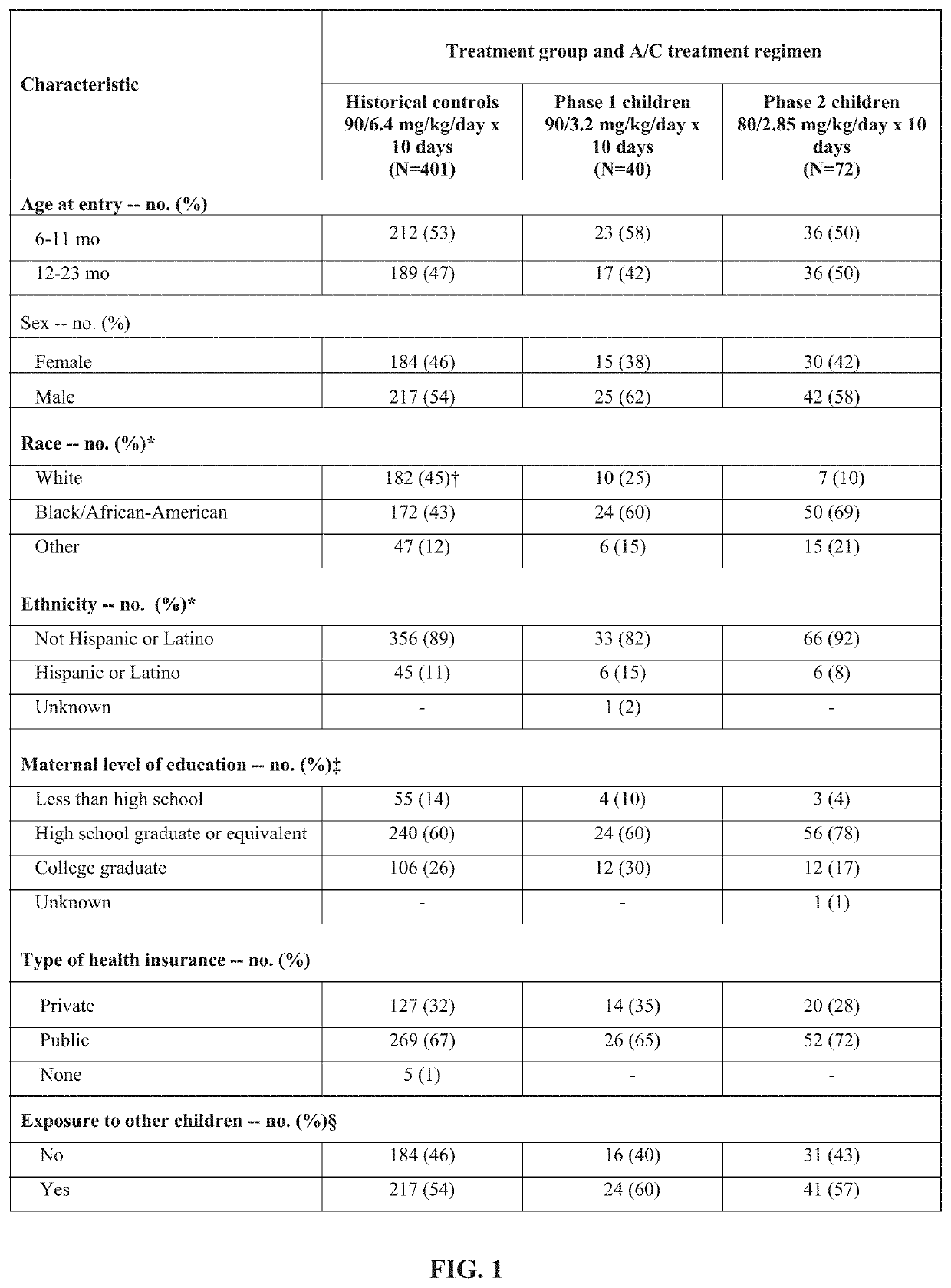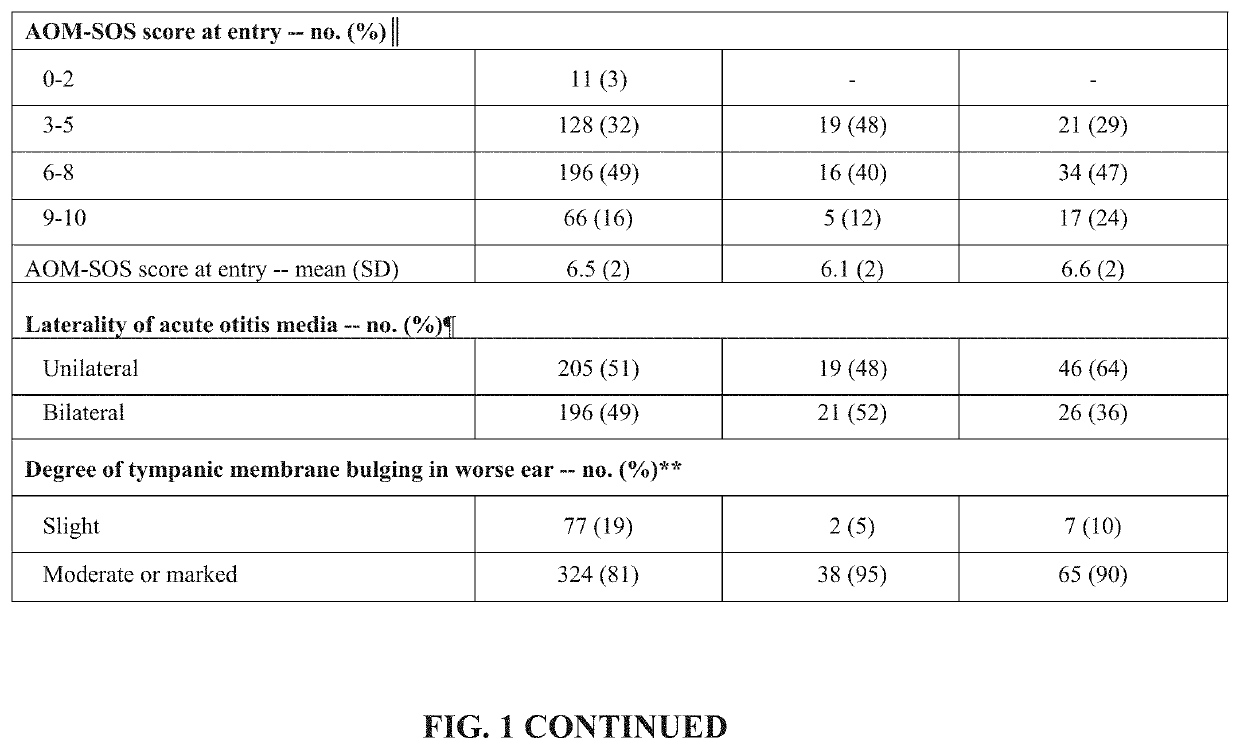Pediatric oral suspension formulations of amoxicillin and clavulanate potassium and methods for using same
a technology of amoxicillin and clavulanate potassium, which is applied in the field of clavulanate potassium oral suspension formulations, can solve the problems of affecting the treatment regimen, the amount of drug delivered is not flexible, and children's tableware and capsules are difficult to swallow, so as to reduce the overall amount of clavulanate potassium, reduce the effect of clavulanate potassium content and maintain the effect of composition
- Summary
- Abstract
- Description
- Claims
- Application Information
AI Technical Summary
Problems solved by technology
Method used
Image
Examples
example 1
ons
[0134]These formulations are provided as examples of possible oral suspension formulations of this invention. It will be apparent that these formulations and many variations of these formulations are available as compositions of this invention. Other types of formulations as discussed above such as aerosols, injectable solutions, capsules, topical formulations, and others can be included among these examples.
Oral Suspension (Amounts in 5 mL)
[0135]200 mg Amoxicillin trihydrate and 3.36 mg (0.15 mEq) sodium
250 mg Amoxicillin trihydrate and 3.39 mg (0.15 mEq) sodium
400 mg Amoxicillin trihydrate and 4.33 mg (0.19 mEq) sodium
20 mg clavulanate potassium
10 mg clavulanate potassium
5 mg clavulanate potassium
Oral Suspension:
[0136]200, 250, 400 mg Amoxicillin trihydrate
20, 10, 5 mg clavulanate potassium
FD&C Red No 3
[0137]flavorings
silica gel
sodium benzoate
sodium citrate
sucrose
xanthan gum
[0138]These ingredients are sieved and milled separately and together, then blended and remilled, compact...
example 2
[0139]In order to confirm the effectiveness of the compositions of this invention, various biological assays can be performed. In vitro studies of various types known for antibiotic use can be used to demonstrate effectiveness and safety. Similarly in vivo studies in animal models can also be used for such purposes. Clinical studies are not required, but clinical data can be included to show the safety and effectiveness of the compositions of this invention.
[0140]Minimum inhibitory concentrations (MICs) or minimum bactericidal concentration (MBC) for relevant bacterial populations can be determined by known quantitative methods. The MIC is the lowest concentration that inhibits visible growth on a plate or reduces turbidity in culture and provide estimates of the susceptibility of given bacteria to the compositions tested. The MBC is the lowest concentration that kills almost all (99.9%) of the original culture in a given period of time.
[0141]For the MIC, the relevant bacteria (for ...
example 3
ation of 2.85-3.2 mg / kg / Day Clavulanate
Abstract
[0145]Amoxicillin / clavulanate (A / C), is currently the most effective oral antimicrobial in treating children with acute otitis media (AOM), but standard dosage of 90 / 6.4 mg / kg / day commonly causes diarrhea. An A / C formulation containing lower concentrations of clavulanate was examined to determine whether it could result in less diarrhea, while maintaining plasma levels of amoxicillin and clavulanate adequate to eradicate middle-ear pathogens and achieve clinical success.
[0146]An open-label study in children aged 6 to 23 months with AOM was conducted. In Phase 1, 40 children were treated with a reduced-clavulanate A / C formulation providing 90 / 3.2 mg / kg / day for 10 days. In Phase 2, 72 children were treated with the same formulation at a dosage of 80 / 2.85 mg / kg / day for 10 days. Children's rates of protocol-defined diarrhea (PDD), diaper dermatitis, and AOM clinical response were compared with rates reported in children who received the sta...
PUM
| Property | Measurement | Unit |
|---|---|---|
| time | aaaaa | aaaaa |
| concentration | aaaaa | aaaaa |
| concentration | aaaaa | aaaaa |
Abstract
Description
Claims
Application Information
 Login to view more
Login to view more - R&D Engineer
- R&D Manager
- IP Professional
- Industry Leading Data Capabilities
- Powerful AI technology
- Patent DNA Extraction
Browse by: Latest US Patents, China's latest patents, Technical Efficacy Thesaurus, Application Domain, Technology Topic.
© 2024 PatSnap. All rights reserved.Legal|Privacy policy|Modern Slavery Act Transparency Statement|Sitemap



